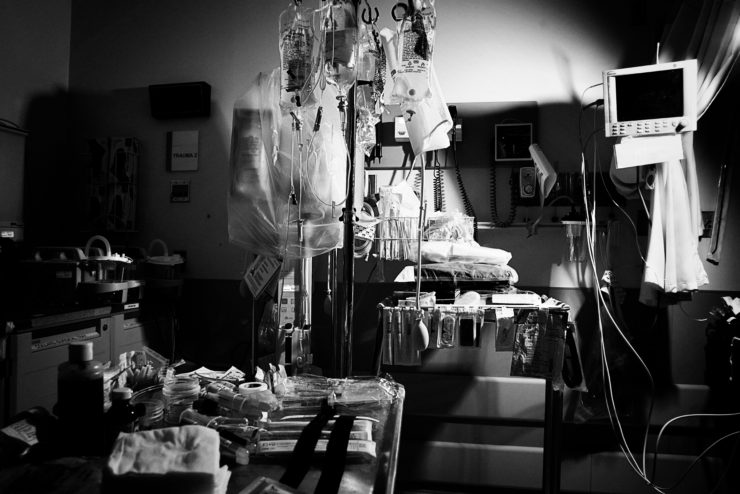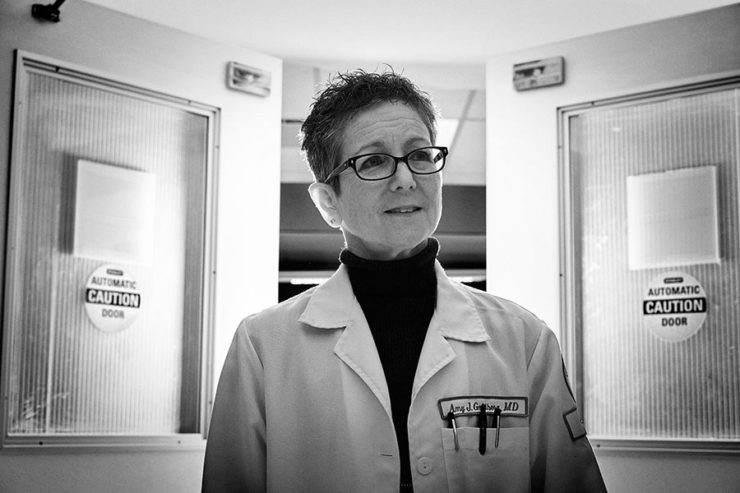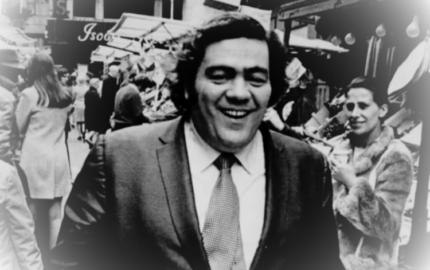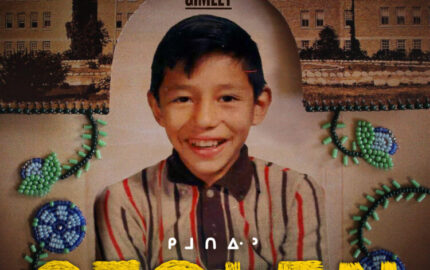Gun violence is one of America’s most pervasive, polarizing issues, and journalism has responded with thousands of articles tackling the subject, including a raft of forgettable think pieces, trend pieces, explainers and data-driven dross.
And then there’s Jason Fagone’s recent, revelatory story for Huffington Post Highline, “What Bullets Do to Bodies.”
America’s gun violence epidemic
This week on Storyboard we’re spotlighting stellar literary journalism about America’s gun violence epidemic from the Huffington Post’s Highline, the Los Angeles Times, The Washington Post and Mother Jones. We welcome your suggestions on other stunning stories about this plague. And please read this great story in Nieman Reports on how newsrooms are covering mass shootings.
Early in the piece, Fagone writes: “We get names, places, anguished Facebook posts, wonky articles full of statistics on crime rates and risk, Twitter arguments about the Second Amendment—everything except the blood, the pictures of bodies torn by bullets. That part is concealed, sanitized. More than 30,000 people die of gunshot wounds each year in America, around 75,000 more are injured, and we have no visceral sense of what physically happens inside a person when he’s shot.”
Trauma surgeon Amy Goldberg does.
Like many of the protagonists that pepper Fagone’s articles and books, Goldberg is a master of her craft, a larger-than-life figure with special access to something most of us don’t know. Goldberg has spent almost her entire 30-year career as a trauma surgeon at Temple University Hospital in Philadelphia, located in one of the most dangerous areas of the country. She has treated hundreds if not thousands of gun violence patients, witnessed the intransigence of Congress and started her own gun-violence programs through the hospital.
Through the profile of Goldberg, Fagone was able to inhabit a fresh ecosystem within the predictable world of gun violence journalism.
I spoke to Fagone by phone, where we discussed overnight reporting trips to the trauma wing at Temple, finding hope in despair, the many barriers to reporting in a hospital and the bittersweet reader reactions.
The interview has been edited slightly for length and flow.

Can you talk about how this story got off the ground? What was your original concept for the piece?
I had been out with friends a couple of years ago, and one of them was a former Philadelphia city prosecutor who worked on gun cases. We were just talking in a cab, and he was telling me about Temple Hospital, and said if I really wanted to understand the gun epidemic in Philly, I should go spend a weekend at Temple University Hospital and watch them treating gunshot patients coming in. I thought that was interesting, that that would be something worth doing, and it was something I didn’t know anything about. I thought it would be worth doing because trauma surgeons see a part of the epidemic that the rest of us don’t. They’re really the only ones that can’t look away from gun violence, because it’s their job to fix people who are hurt.
But I kind of put it in the back of my mind, because in the beginning, I had the sense that it would be tough to get access to the trauma ward of a hospital. Then recently, I saw a news story about Dr. Amy Goldberg becoming chair of surgery, and then I thought that was interesting, because I imagined there weren’t a lot of women chairs of surgery at major teaching hospitals, and that turns out to be true: There are 16 in the United States. So, that seemed significant, and then I read about some of their outreach programs where they go into the community and bring members of the community into the hospital and actually teach them about what trauma surgeons have to do to save people who are shot. I pitched them a simple profile of Goldberg, asking to shadow Goldberg on a call shift, watch her perform surgery and try to understand her view of gun violence and what she sees in the trauma bay. At that point there were some back-and-forth negotiations about patient privacy. We ended up signing a piece of paper with them saying that I’m not a doctor, I’m not going to be performing any surgery in the hospital, and that I must abide by patient privacy regulations and cannot use any information or interview anyone who has not given consent.
What do you think you were able to reveal about gun violence in general — the various costs, to physical life, to emotional well-being, to communities, to doctors and surgeons — by narrowing your narrative down to this individual surgeon?
“I thought it would be worth doing because trauma surgeons see a part of the epidemic that the rest of us don’t. They’re really the only ones that can’t look away from gun violence, because it’s their job to fix people who are hurt.”
I think with any profile, you’re not just writing about the person but about the world that they move in. You’re learning about the person, but at the same time you’re learning about the world that they have access to but you don’t, that you don’t normally get to see. Kind of the idea with pitching a profile of Goldberg was that not only is she, in her own right, a compelling person, someone who has worked for 30 years in the same institution doing this very intense, difficult and high-stakes work, but she also has a view, a window into this bigger problem that most people don’t have.
Then I had that first conversation with her, which ended up in the lead of the story, where almost straight off the bat she was almost berating me — and berating all journalists by extension — about our impotence in being able to get the story across, or affecting any type of change. I think it was right after the Pulse nightclub shooting in Orlando, which was horrifying, and I think she was horrified. Horrified. She’s being doing this for 30 years. How many regular, week-in, week-out handgun shootings has she seen? And that’s where she made the connection from mass shootings and the kind of violence she deals with in north Philly, which is what she says later in the piece, something like, “If America didn’t care about 20 white kids getting murdered in Sandy Hook, there’s no way they can care about black patients that I treat in north Philadelphia.”
I wanted to ask about that quote. It feels like a real cynicism towards change. Yet she is doing so much, on top of her surgery, to change the violence outcomes in her community.
Something about that really resonated with me. How does someone who’s been doing this work fight that despair, in a culture that’s not doing anything about it? There’s no help that’s coming through. The cavalry isn’t coming. She has to know that, and she has to go into work every day knowing that, and find a way to keep doing it, and find a way to keep marshaling resources of her hospital within a larger culture that’s not giving her any help. Eventually the story became about that despair, both the larger despair of the national gun debate, and the smaller despair that she deals with every day, and how she overcomes that.
What was your experience like in the hospital, shadowing Goldberg?
I spent around 100 hours with Goldberg on call, two or three 24-hour shifts and the rest 12-hour overnight shifts. Obviously she’s not performing surgery all of that time. A lot of that time was down time, where nothing’s happening. Basically we were just there with a trauma pager, and whenever it would go off, we would make a decision about whether to go down to the ER and try to get into the trauma bay. Whenever it was a gunshot patient, we went, as well as for some other types of surgeries.
I didn’t see a thoracotomy, so I didn’t see the most dramatic intervention they have to do, where they have to open the chest. It was partially the randomness of the days, the unpredictability of the days, and the fact that on all the days I went, those were not days that needed thoracotomies. I did observe gun surgeries and other kinds of trauma surgeries, like pedestrians hit by automobiles, and so on.
Could you have done this with a regular trauma surgeon? How was the story made whole by the character of Goldberg?
I think you really need that central person to hold your attention. Don’t you think so? I kind of felt that you need that person who can hold your hand and walk you through it, and someone who is willing to be open about these things in a way that doctors often aren’t. And also patient privacy regulations are very onerous, so it’s a little bit of a risk to let a reporter into a hospital. Hospitals are sort of inimical environments to journalists. So we were very concerned about that, and very aware of that the whole time. We worked very closely with them to make sure we weren’t putting any patient privacy rights at risk. There were two levels of consent. If there was verbal consent, I could observe a surgery, but beyond that if I wanted to interview a patient, it required signing a consent form. There were a lot of people who said no, and a lot where it just wasn’t possible because the people weren’t conscious when they came in. That’s one of the reasons the story took so long to do, because it’s just extremely difficult for journalists working in a hospital.
But the story really required a commitment to openness from Goldberg, her colleagues and the hospital. They had to really want to tell the story, and without that commitment, it wouldn’t have been possible.
Looking at all that Goldberg has had to do, almost unilaterally, to prevent and intervene on gun violence, it presents a damning case against our government’s intransigence. Is that what you were trying to build, but not blatantly say (except in the article’s description)? Do you think that these community-based efforts could be more effective than federal policies?
That’s a good question. I really don’t know; I feel like I’m not qualified to answer that. Part of what appealed to me about that story was that it kind of sidestepped a lot of the usual ways of talking about gun violence. I find a lot of arguments about gun violence to be saturated, in a really irritating way, with statistics about risk, or a distorting, beside-the-point focus on crime rates going down or crime rates going up. I wasn’t as interested in that as I was in Goldberg’s lived experience of doing this work for 30 years. In the way that this story connected with people, I think that’s what they connected with. It’s not really talking about it in the usual way, right. It’s talking about this one person’s efforts, and her team’s efforts, to help their patients in their part of the city. And doing heroically, I’d say, and very methodically, with a lot of meticulous research, and doing it kind of day-in, month-in, year-in and year-out. That’s what striking about it to me. And I also probably absorbed some of their disdain with how lots of journalists and experts talk about it. They’re not as interested in speaking on panels, but more interested in doing things in the science, gathering data and doing things in small concrete ways that make things better. Scott Charles’ gun lock program is emblematic of that, to me. Gun locks are a small, concrete way of making gun violence better. Scott found a source of gun locks and just started giving them away for free. And I think he would rather give away a box of gun locks than go speak on a dais somewhere, and that’s kind of the whole ethos of the program.
“How does someone who’s been doing this work fight that despair, in a culture that’s not doing anything about it? There’s no help that’s coming through. The cavalry isn’t coming. She has to know that, and she has to go into work every day knowing that, and find a way to keep doing it, and find a way to keep marshaling resources of her hospital within a larger culture that’s not giving her any help.”
What was the reaction to the piece like?
It surprised me, because the story began with the futility of our journalistic endeavors around guns, but I think people connected to it because they connected to her. The story resonated because something about her experience — and her way of speaking about her experience — resonated. That’s been really gratifying. I’ve gotten emails from readers of the story that are unlike emails I’ve gotten on any other story. The other day I got an email from a guy who said he was a staunch Second Amendment supporter before he read the story, and it made him rethink his views. I got a number of emails from people who said they don’t normally like the media that much [chuckles], they don’t like reporters, but they thought the story had more depth than things they normally read. Those are kind of bittersweet emails to get, I guess. But yeah, I feel like it really did resonate with people somehow. I’m not exactly certain why, but I know that it did.
What are you looking for with a story, and how did this fit?
I’m always looking for someone like Goldberg. A master at what they do, who has access to a world that we don’t normally see or know that much about. To watch a professional work at that level is always great. And her being willing to talk about it, and be fairly open about the emotional toll that it takes on her and other people, that’s something else you look for: Someone who is willing to speak to you, fairly candidly. And the aspect of it where I was getting to see and be shown something people don’t normally see, that was a goal, too. I hate having to compete with other reporters. I just despise it. I’ve done kinds of reporting where I’m in the room with 30 other journalists, and I will do anything to not have to do that. If it means I will have to go very far out of my way, I will, because I can’t stand reporting a story other journalists are reporting.
I live in Philly, I’m not that far from the hospital, so I could take my time with it. I was local to them, so I could get into the hospital fairly easily and come back again and again. It wasn’t like I was flying in from somewhere else and if I didn’t get the story in one day, that’s it. And this was a story that I felt fairly passionate about. As soon as I got in, and soon as I talked to Goldberg, I just saw how passionate they were about what they do. They had such a unique perspective on this national issue, and you combine that with their passion and their belief, and it was really kind of novel to me. There’s something compelling, really irresistible about that. That keeps you going, and that was definitely the case here.
You’re from Philly and the story is a very Philly-centric one. Since this was for a national outlet, were you tempted to nationalize the story at all?
No. Why? No. There was never a discussion about that with our editors, either. They wanted to know about her experience at Temple University Hospital in north Philadelphia. I think it speaks to other hospitals and other trauma centers around the country, too, though. There’s nothing that a surgeon at the Cook County trauma center in Chicago, or in Los Angeles, or Atlanta, wouldn’t recognize as being part of their experience. Temple isn’t unique in that sense. It’s very similar to these other trauma centers in large urban areas around the country, and the kinds of expertise that they have, and the types of interventions they do is similar to what is done everywhere. But I do think there are very few people like Goldberg, who has spent 30 years at the same large trauma center and literally treated thousands of gunshot patients. Thirty years. There’s just so few people who have her broad view of it, and her standing to speak about it.



